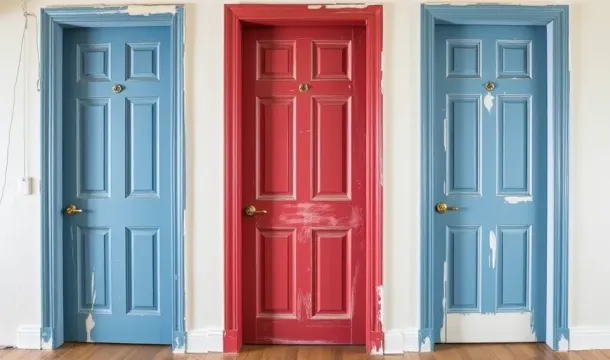The Impact of Insulated Interior Doors on Home Energy Efficiency
Popular Articles
To enhance your home's thermal performance, consider upgrading to well-crafted barriers that significantly reduce heat transfer. These features not only create a more stable environment but also contribute to remarkable reductions in utility costs.
By selecting products designed with advanced insulation technology, you can drastically improve overall efficiency. This strategic choice leads to lower energy consumption, directly impacting your monthly bills and supporting a sustainable future.
The right selection of internal partitions plays a pivotal role in maintaining desired temperatures throughout various seasons. Investing in high-quality models will yield substantial long-term savings, ensuring that your living space remains comfortable without the burden of excessive energy expenses.
Choosing the Right Materials
Selecting appropriate substances for your barriers can significantly influence thermal management within your residence. Opt for materials with high R-values, which measure resistance to heat flow; this indicates better insulation properties. Fiberglass and solid-core wood are excellent choices, providing durability while minimizing energy transfer.
Consider composite materials that combine various elements to enhance performance. For example, a core of polystyrene or polyurethane sandwiched between layers of engineered wood can maximize insulation while maintaining structural integrity. Such configurations effectively limit air leakage and improve overall thermal performance.
Evaluate the exterior surface finishes as well. A factory-applied sealant not only adds aesthetic appeal but also contributes to moisture resistance, prolonging the lifespan of your structures. Look for finishes that are eco-friendly and low in volatile organic compounds (VOCs) to ensure indoor air quality remains unaffected.
Your geographical zone plays a crucial role in material selection. In colder climates, denser materials may be more advantageous, while warmer regions could benefit from lighter options that reflect rather than absorb heat. Tailoring choices based on local conditions enhances overall efficiency.
Lastly, explore sustainable alternatives like bamboo or reclaimed wood which offer both style and environmental benefits. These materials often provide adequate insulation while minimizing ecological footprints, aligning with modern preferences for green living solutions.
Installation Tips for Insulation
Ensure a snug fit: Measure door frames accurately before installation. Gaps can lead to thermal loss, impacting climate control and increasing utility expenses.
Use quality materials: Select insulation products that suit local weather conditions. High R-value materials provide better resistance to heat transfer, enhancing overall performance.
Seal edges properly: Apply foam or caulking around the perimeter of the frame after fitting the panels. This minimizes air leaks, contributing to improved temperature regulation within living spaces.
Consider soundproofing: If noise reduction is a priority, look for sound-dampening insulation options. This can enhance comfort while further optimizing resource usage in your residence.
Install with care: Follow manufacturer guidelines closely during assembly. Incorrect installation may negate any advantages gained from upgraded materials, leading to increased costs over time.
Regular maintenance: Periodically check seals and insulation integrity. Addressing any wear or damage promptly can sustain effectiveness and prolong the lifespan of your installation.
Create an airtight environment: Ensure all adjoining areas are also insulated well. Comprehensive coverage across your space maximizes energy conservation efforts and reduces heating and cooling demands.
Select appropriate tools: Use a level, measuring tape, and proper fasteners for precise alignment. The right equipment facilitates smoother installation processes and enhances final results.
Aim for professional assistance if needed: If unsure about installation methods, hiring skilled contractors can ensure correct application, maximizing efficiency and minimizing future issues.
Impact on Heating Costs
Implementing well-insulated barriers within your residence can significantly reduce heating expenses. By minimizing heat loss, these structures create a more stable temperature environment.
Consider the following points regarding their influence on energy expenditures:
- Thermal Resistance: Enhanced insulation provides a higher R-value, which directly correlates with reduced thermal transfer. This means less energy is required to maintain comfortable temperatures.
- Localized Climate Control: Strategically placed barriers help contain warmth in specific areas, decreasing the reliance on central heating systems and leading to substantial reductions in utility bills.
- Energy Efficiency: Improved design limits drafts and air leakage. This not only contributes to comfort but also optimizes the overall efficiency of heating appliances.
Studies indicate that homes utilizing quality insulation can see savings ranging from 10% to 20% in heating costs annually. The initial investment in proper materials pays off through long-term reductions in energy consumption.
In addition, seasonal adjustments are easier to manage when heat is retained effectively, allowing for more tailored climate control strategies throughout the year.
The cumulative impact of these strategies creates a notable decline in energy-related expenses while enhancing overall comfort levels within your living space.
Maintenance for Longevity
Regular upkeep is vital for maximizing the lifespan of your thermal barriers. Inspect seals and weather stripping at least twice a year to ensure they remain intact, preventing drafts that compromise insulation performance. Replace any worn-out materials promptly to maintain optimal efficiency.
Keep surfaces clean by wiping them down with a mild detergent solution. This not only enhances appearance but also prevents buildup that could affect material integrity over time. Avoid harsh chemicals that may degrade finishes.
Monitor humidity levels within your living space; excessive moisture can lead to mold growth, which negatively impacts both air quality and structural elements. Utilize dehumidifiers in damp seasons to maintain a balanced climate.
Assess hardware functionality periodically. Hinges and locks should operate smoothly without resistance. Lubricate moving parts as necessary to prevent wear that could lead to costly repairs.
Consider periodic professional evaluations, especially if you live in extreme climates. Experts can identify potential issues early, ensuring ongoing energy efficiency and minimizing long-term expenses associated with replacements or major fixes.
Popular Articles

Choosing the Perfect Interior Doors for Your Canadian Home

A Complete Guide to Choosing Interior Doors for Canadian Homes
